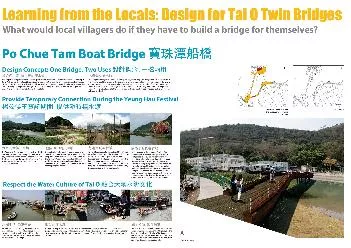/


The proposed design seeks to respond to the architectural tradition of Tai O The site offers a panoramic view of the stilted houses the fishing ponds the mangrove forest and the mountain in the ba ID: 180473
Download Pdf The PPT/PDF document "Design Concept: Life on the Stilted Deck..." is the property of its rightful owner. Permission is granted to download and print the materials on this web site for personal, non-commercial use only, and to display it on your personal computer provided you do not modify the materials and that you retain all copyright notices contained in the materials. By downloading content from our website, you accept the terms of this agreement.
Design Concept: Life on the Stilted Deck Yim Tin Sliding Bridge The proposed design seeks to respond to the architectural tradition of Tai O. The site offers a panoramic view of the stilted houses, the fishing ponds, the mangrove forest, and the mountain in the background. As such, the proposed bridge should be simple and subtle so that visitors to the site can enjoy the picturesque panorama. To match the environment, the proposed bridge consists of a number of stilted wooden decks similar to those built by the locals. Extending from the two sides of the river, these wooden decks sit on mechanical sliding tracks and can be positioned to form a linking bridge.Tai O was once famous for the manufacturing of salt. The proposed bridge at Yim Tin is located at the original site of the old Taishan salt fields. In the past, a row of stilted houses were built on the embankment separating the salt fields and the river. Unfortunately, the stilted houses and the salt fields have been gone and they remain only in the memory of the Tai O people. In our public space design, we propose to construct a number of stilted wooden decks on the embankment which follows the old footprint of the demolished structures to retrieve the memory to the historic salt industry in Tai O. Tai O is dominated by the stilted houses built over or on the edge of the river. Constructed by the villagers themselves, these stilted houses formed the unique character of Tai O. They are, and should continue to be, the main focus of the site. The design of the Yim Tin Bridge should respond to the strong characters of the stilted house. An elaborated bridge which blocks the view to the stilted houses is inappropriate to the site context and should be discouraged.In our proposal, we adopt a humble bridge design that goes harmony with the surrounding stilted houses. Whenever the locals need to link up two places, they build a stilted wooden desks as the passageway. This kind of stilted passageway spread all over Tai O. Our proposed bridge design seeks to follow this design tradition and language.Avoid Strong Visual Impact Tai O has a strong self-build tradition. Most of the stilted houses are constructed by the villagers themselves.Most stilted houses are attached to a wooden deck which serves as an extended living space for the villager's family. Often, the stilted decks of individual families are connected to form a continuous passageway.Besides building their own stilted houses, Tai O villagers used to construct public passageway and bridges in their community. They tend to use timber as the main construction material. The design is often plain, simple, and humble.Timber construction is undergoing a significant revival nowadays because the material is strong, durable, and renewable. The timber bridges of today offer the same standard of performance and technical lifespan as bridges made of steel and concrete.Traditionally, local villagers prefer to use a special type of wood called kun dian for the construction of their stilted houses. Kun dian wood offers strong resistance to water and is an ideal building material for our bridge.The main structure of the bridge will be made of glulam beams and girders to offer bigger strength and longer span. The finished glulam structure will be suitably coated with either a penetrating sealer or film-forming coating.The surfacing material of the bridge will be made of pressure-treated hardwood boards. It provides a durable surface able to withstand the weight of vehicles.MASTER LAYOUT PLANStilted decks extended tobecome a sliding bridge AERIAL PHOTO OF TAI O (1963)Showing the stilted houses onthe embankment separating theTai Shan Salt fields and the river PERSPECTIVE VIEW CONCEPT DIAGRAMRecreating the profile ofthe demolished stilted houses 123 ELEVATION 1: 200CROSS SECTION 1: 30 EMERGENCY VEHICLE HARDWOOD CURB PRESSURE-TREATED HARDWOOD DECK BOARDJOISTTRANSVERSE BEAMGLULAM WOOD PANELELECTRICALLY OPERATEDMECHANICAL G GEARSTEEL ANGLETIMBER POST3000 CLEAR TRANSVERSE BEAMGLULAM GIRDERSTEEL ANGLETIMBER POST3000 CLEAR PRESSURE-TREATED HARDWOOD DECK BOARDJOISTHARDWOOD CURBWOOD PANEL Perspective view - Linked bridgePerspective view - The bridge is open for the parade of the Dragon Boat PERSPECTIVE VIEWPERSPECTIVE VIEW +4.20mPD +6.40mPD +3.16mPD EVA KEY PLAN ABC